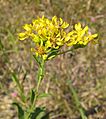Stiff goldenrod facts for kids
Quick facts for kids Stiff goldenrod |
|
|---|---|
 |
|
| S. rigida subsp. humilis | |
| Scientific classification | |
| Genus: |
Solidago
|
| Species: |
rigida
|
| Synonyms | |
|
Synonymy
Aster rigidus (L.) Kuntze 1891 not L. 1753
Oligoneuron grandiflorum (Raf.) Small Oligoneuron rigidum (L.) Small Solidago grandiflora Raf. Aster jacksonii Kuntze, syn of subsp. glabrata Leioligo corymbosa (Elliott) Raf., syn of subsp. glabrata Oligoneuron corymbosum (Elliott) Small, syn of subsp. glabrata Oligoneuron jacksonii (Kuntze) Small, syn of subsp. glabrata Solidago corymbosa Elliott 1823 not Poir. 1817, syn of subsp. glabrata Solidago jacksonii (Kuntze) Fernald, syn of subsp. glabrata Oligoneuron bombycinum Lunell, syn of subsp. humilis Oligoneuron canescens Rydb., syn of subsp. humilis Solidago bombycina (Lunell) Friesn., syn of subsp. humilis Solidago bombycinum (Lunell) Friesner, syn of subsp. humilis Solidago canescens (Rydb.) Friesner, syn of subsp. humilis Solidago parvirigida Beaudry, syn of subsp. humilis |
|
Stiff goldenrod, also called stiff-leaved goldenrod, is a plant found in North America. It belongs to the aster family, which includes many well-known flowers. You can find this plant mostly in Canada and the United States, especially east of the Rocky Mountains. It likes to grow in sunny, dry places. These include prairies, savannas, and open grassy areas with chalky or sandy soil.
Contents
What is Stiff Goldenrod Like?
Stiff goldenrod is a tall plant with many leaves. It is a perennial, meaning it lives for more than two years. Its leaves are tough and feel like leather. They are quite large for a goldenrod plant. Each leaf can be about 3 to 6 centimeters (1 to 2.5 inches) wide. They can also be 8 to 20 centimeters (3 to 8 inches) long.
This plant grows bright yellow flowers. These flowers appear in bunches during the late summer and fall. After the flowers, the plant produces small fruits. These fruits are called achenes. They are spread by the wind, helping the plant to grow in new places.
Different Kinds of Stiff Goldenrod
Just like there can be different types of apples, there are different types of stiff goldenrod. These are called subspecies. They are all the same main plant, but they have small differences.
- Solidago rigida subsp. glabrata (E.L.Braun) S.B.Heard & Semple – This type is found in the southeastern and south-central parts of the United States.
- Solidago rigida subsp. humilis (Porter) S.B.Heard & Semple – This type grows in central and western Canada. It is also found in the central and western United States, reaching as far west as the Rocky Mountains.
- Solidago rigida subsp. rigida – This kind is found in Ontario, Canada. It also grows in the central and eastern United States.
Protecting Stiff Goldenrod
Experts at NatureServe say that stiff goldenrod is generally "secure" around the world. This means it is not in danger of disappearing globally. However, in some local areas, it is becoming rare. This is because the grassy places where it likes to grow are shrinking.
Because of this, stiff goldenrod is listed as endangered in some states. These include Connecticut, New Jersey, and Pennsylvania. It is also listed as endangered and no longer found in Maryland. In New York, it is considered threatened. In Rhode Island, it is only known from historical records.
How Native Americans Used This Plant
Native American tribes used stiff goldenrod for different purposes.
- The Ojibwe people made a special liquid from the plant's root. They used this to help with certain health issues. They also drank a tea made from the root to help with problems related to urine.
- The Meskwaki tribe used the flowers to make a lotion. They put this lotion on bee stings. They also used it to help with swollen faces.


